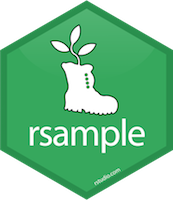rsample contains a set of functions that can create different types of resamples and corresponding classes for their analysis.
The goal is to have a modular set of methods that can be used across different R packages for:
- traditional resampling techniques for estimating the sampling distribution of a statistic and
- estimating model performance using a holdout set
The scope of rsample is to provide the basic building blocks for creating and analyzing resamples of a data set but does not include code for modeling or calculating statistics. The "Working with Resample Sets" vignette gives demonstrations of how rsample tools can be used.
To install it, use:
install.packages("rsample")
## For the devel version:
require(devtools)
install_github("tidymodels/rsample")Note that resampled data sets created by rsample are directly accessible in a resampling object but do not contain much overhead in memory. Since the original data is not modified, R does not make an automatic copy.
For example, creating 50 bootstraps of a data set does not create an object that is 50-fold larger in memory:
> library(rsample)
> library(mlbench)
> library(pryr)
>
> data(LetterRecognition)
>
> object_size(LetterRecognition)
2.64 MB
>
> set.seed(35222)
> boots <- bootstraps(LetterRecognition, times = 50)
>
> object_size(boots)
6.69 MB
>
> # Object size per resample
> object_size(boots)/nrow(boots)
134 kB
>
> # Fold increase is <<< 50
> as.numeric(object_size(boots)/object_size(LetterRecognition))
[1] 2.528695The memory usage for 50 boostrap samples is less than 3-fold more than the original data set.
